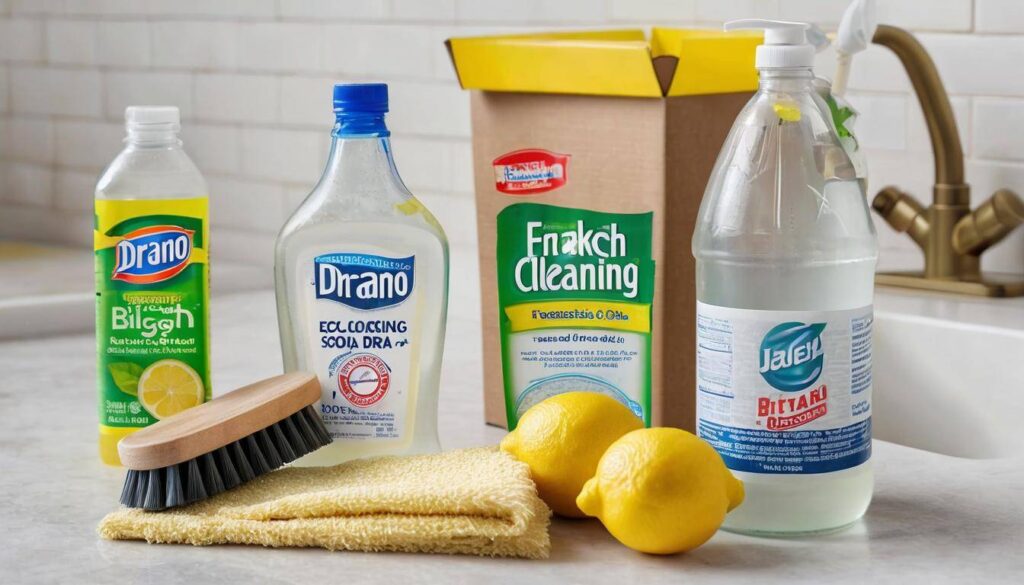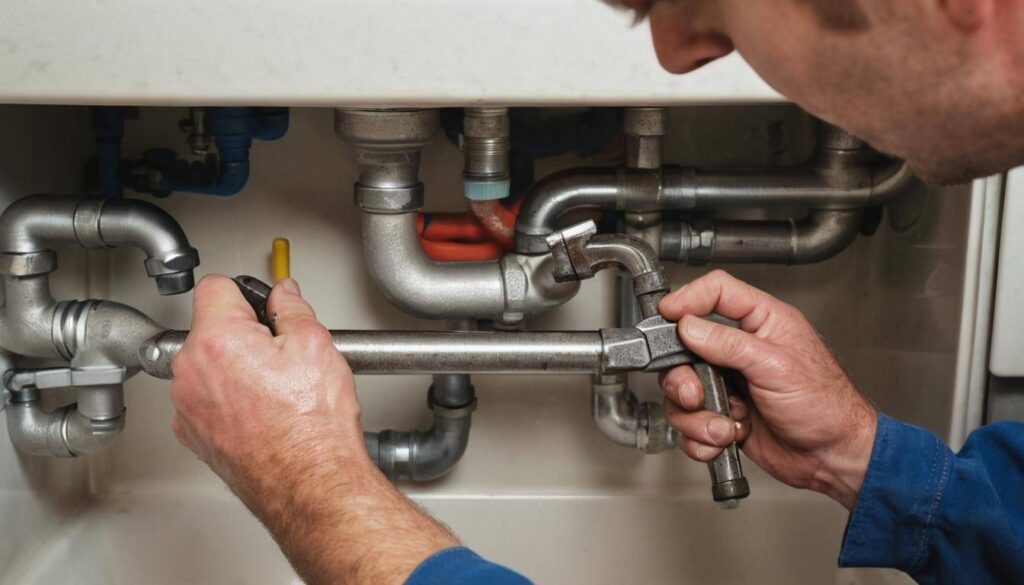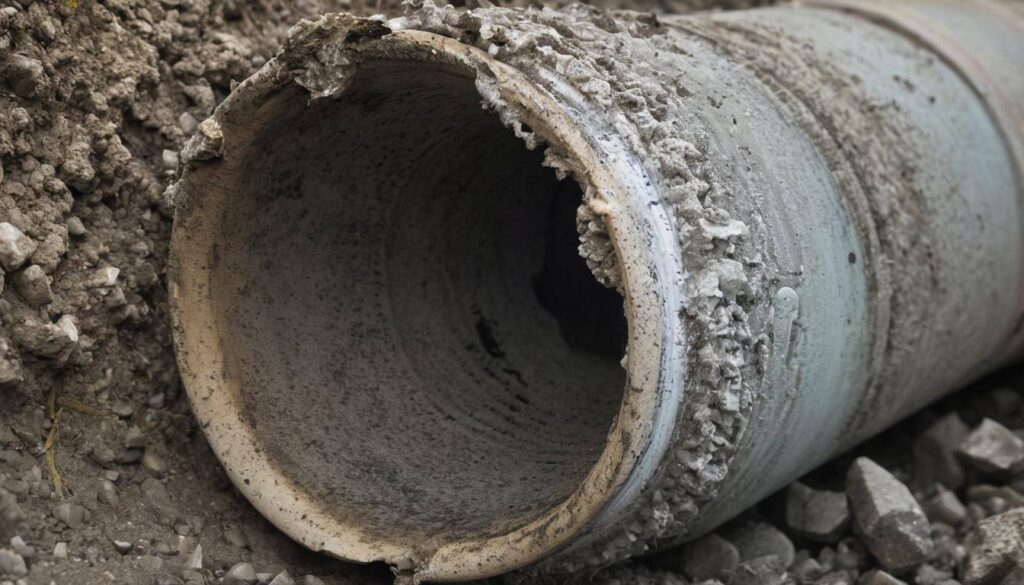Signs of a Burst Pipe in the House: How to Identify and Take Action
Detecting a burst pipe in your Calgary house isn’t akin to finding a needle in a haystack. Clear indications like water stains and sound of running water on your ceilings, walls or floors can signal a burst pipe. But remember, not all superheroes wear capes; sometimes, they manifest as unexpected silence. When the usually noisy pipes become eerily quiet, it can be an offbeat sign of a severe issue. Know this – when water speaks to you through stains and whispers, it’s time for action.
Common signs of a burst pipe in your home may include water stains on walls or ceilings, unusual water puddles or dampness on the floor, reduced water pressure, or unexplained spikes in your water bill. If you notice any of these signs, it’s important to contact a professional plumber to assess and address the issue promptly.
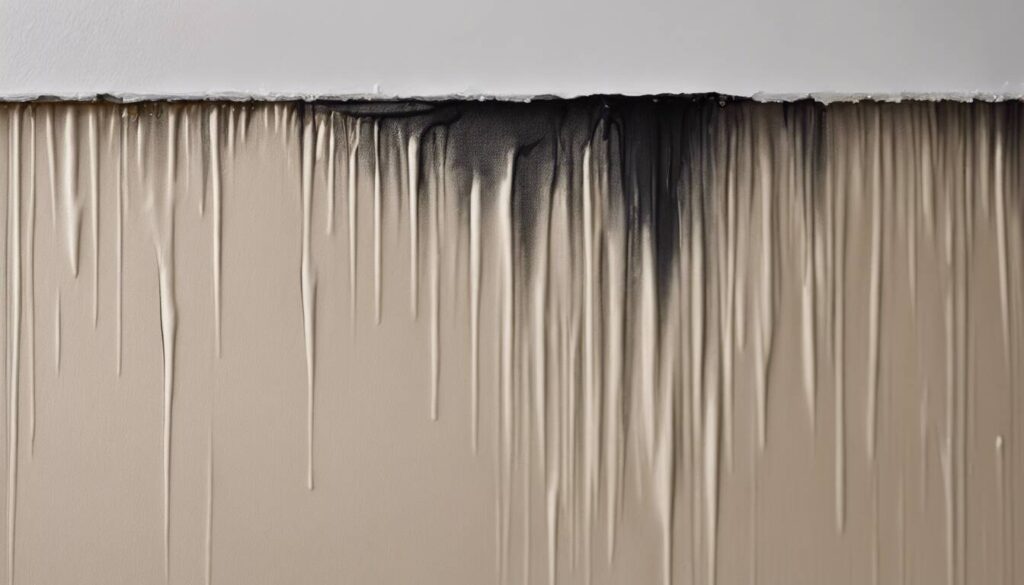
Common Signs of a Burst Pipe in Your Home
A burst pipe can wreak havoc in your home if not detected early. One of the most obvious signs is water damage. Keep an eye out for any water stains or discoloration on your ceilings, walls, or floors. If you notice these, it could be a sign that there’s been a leak and water has seeped into areas where it shouldn’t be. Listen closely for any unusual noises like drips or running water, which may indicate water escaping from the pipes.
Another key indicator is low water pressure. If you suddenly experience a significant drop in water pressure, it could signal that there’s a leak somewhere in your plumbing system. This is because the water that should be flowing through your pipes is escaping through a crack or hole instead of reaching its intended destination.
Moreover, keep an eye on your water bills. A sudden, unexplained increase in your water bills without any changes in your usual water usage can be a red flag. An unnoticed leak can lead to a surge in water consumption, causing your bills to rise unexpectedly.
For instance, let’s say your normal water usage stays consistent month after month, but all of a sudden, you’re hit with a significantly higher bill without having made any changes to justify it. This could be an indication that water has been leaking and going to waste without your knowledge.
Lastly, mold and mildew can provide important clues to the presence of hidden leaks. If you notice the growth of mold or mildew in places where there is usually little to no moisture, it may suggest that there’s an underlying issue with leaking water.
By paying attention to these common signs, you can catch a burst pipe early and prevent further damage to your home and belongings.
Understanding the signs of a burst pipe is just the first step toward resolving this household nightmare. Now, let’s move on to uncovering the hidden source behind this chaos.
Unmasking the Culprit: How to Identify the Source
Identifying the source of a burst pipe can be crucial in preventing extensive water damage to your home. Visual inspection plays a key role in addressing this. Exposed pipes should be carefully examined in areas like basements, crawl spaces, and under sinks for visible leaks or signs of corrosion. Corrosion often indicates a prolonged problem that could lead to eventual pipe failure.
Additionally, regularly check for moisture, discoloration, or mold growth around pipes. These can be indicative of an ongoing leak and should prompt immediate attention to avoid structural damage or health hazards from mold.
Moving on from visual cues, monitoring the water meter can also provide valuable information when trying to locate a burst pipe. To do this, turn off all sources of water and then observe the water meter. If there is any movement in the meter readings with no water being used, it implies that there might be a leak somewhere in the system. This method allows you to confirm if there’s an issue without needing to find its exact location—though keep in mind that this method might not pinpoint the leak but rather reveal its existence.
For instance, if you notice a change in readings while all water sources are turned off, it could suggest that there is indeed a leak present and further investigation is required to identify its specific location.
Lastly, utilizing a leak detection kit can be an effective way to pinpoint the exact location of a leak within your plumbing system. These kits are designed to use sound, temperature changes, or visual cues to identify the source of leaks accurately. Using such technology can help in identifying leaks hidden behind walls or beneath floors—a task that might otherwise require extensive and invasive exploration.
Remember that early detection of a burst pipe can save you from dealing with extensive water damage or high repair costs later on. It’s always better to be proactive when it comes to protecting your home from potential plumbing issues.
By being diligent in visually inspecting your pipes, checking the water meter for unusual activity, and leveraging modern leak detection technology, you can take steps towards unmasking the culprit behind a burst pipe and safeguarding your home against potential damages.
Areas Prone to Burst Pipes
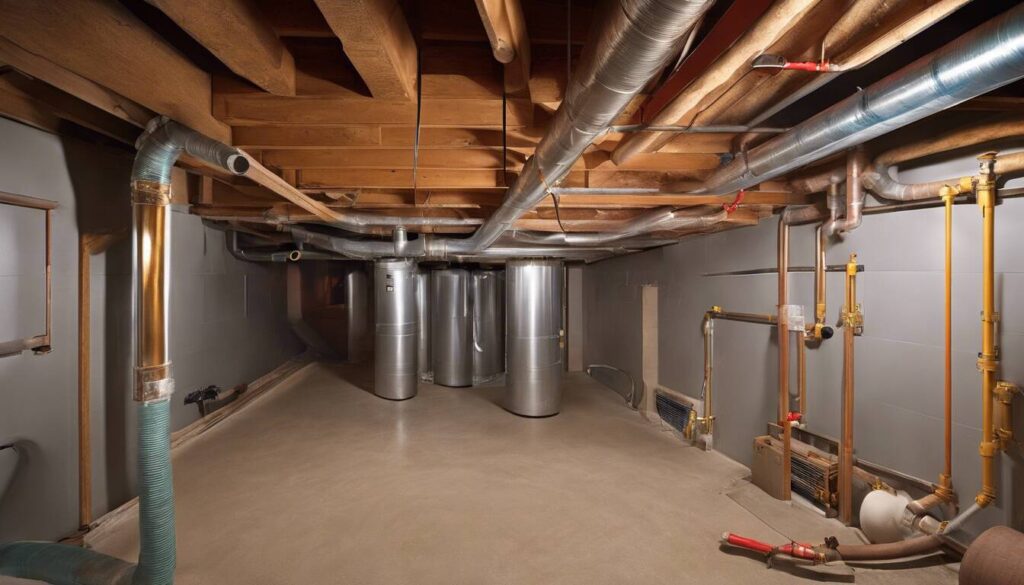
The last thing you’d want is for a burst pipe to catch you by surprise. To prevent this from happening, it’s crucial to understand which areas in your home are most prone to this issue. Let’s take a closer look at these vulnerable spots.
Exterior Walls
Pipes running through exterior walls face a higher risk of freezing and subsequent bursts, especially in colder climates. When the temperature drops, these exposed pipes are more susceptible to extreme cold, putting them at a greater risk of freezing compared to those located within the interior walls of your home. As the water inside the pipes freezes, it expands, increasing the pressure in the pipe and potentially causing it to burst.
To prevent this, it’s important to consider installing additional insulation around these exposed pipes as a protective measure. By bolstering the insulation within exterior walls, you can help shield these pipes from frigid outdoor temperatures, reducing the likelihood of freezing and subsequent bursts.
Unheated Spaces
Pipes located in unheated areas such as attics, crawl spaces, or garages are particularly vulnerable to freezing. Due to the lack of adequate warmth in these spaces, the pipes within are at risk of dropping to temperatures that can cause them to freeze and ultimately burst.
It’s essential to prioritize maintaining appropriate temperatures in these unheated areas during cold weather spells. Installing heating tape or cables around exposed pipes in these spaces can also provide an added layer of protection by ensuring that the pipes remain above freezing temperatures, thereby preventing potential bursts.
Areas with Poor Insulation
Homes with insufficient insulation in walls and around pipes are at an increased risk of experiencing frozen or burst pipes during colder temperatures. Inadequate insulation directly exposes pipes to harsh external conditions, making them more susceptible to the detrimental effects of cold weather.
For instance, inadequate insulation within an external wall can allow cold air to penetrate through to the pipes running within it, leading to a heightened risk of freezing and subsequent bursting.
Therefore, prioritizing proper insulation within your home presents a proactive approach towards safeguarding your pipes from freezing and bursting, ultimately fortifying your property against potential water damage and costly repairs.
By understanding and addressing these vulnerable areas in your home, you can take proactive measures to mitigate the risk of burst pipes and prevent potential water damage down the line.
Leading Causes of Pipe Bursts
We don’t often think about what goes on behind our walls or beneath our floors, but the health of our plumbing is just as important as what we see every day. Burst pipes can cause significant damage, and knowing how to prevent them is crucial. Here are several common causes of burst pipes and what you can do to mitigate these risks.
Freezing Temperatures
During colder months, frozen pipes are a major concern. When water inside a pipe freezes, it expands, creating pressure in the pipes. This increase in pressure can lead to pipes bursting. It’s like trying to fit too much food in a container – something has to give! To prevent this, consider insulating your pipes in unheated areas such as basements, attics, and crawl spaces. Additionally, allowing faucets to drip during extremely cold temperatures can relieve some of the pressure inside the pipes.
Corrosion
Over time, pipes can deteriorate due to corrosion caused by a variety of factors, such as water acidity, high oxygen levels, and the type of materials used in the plumbing system. This deterioration leads to weak spots in the pipes that can eventually result in bursts. Regular maintenance and inspections can help identify signs of corrosion early on, allowing for timely repairs or replacements before they escalate into more severe issues.
Corroded pipes not only pose a risk of bursting but also have potential health implications, especially if lead is present in older plumbing systems. If you live in an older home or suspect corrosion in your plumbing, consider having your water tested for lead content and consult a professional plumber for an inspection.
High Water Pressure
Excessive water pressure puts undue strain on pipes, making them susceptible to rupture. To put this into perspective, think about a balloon being filled with air until it pops—similarly, high water pressure can cause pipes to burst. It’s important to ensure that your water pressure is within a safe range by using a pressure gauge that can be easily attached to an outdoor faucet. Most residential plumbing systems operate best at water pressures between 40-80 pounds per square inch (psi).
Understanding these common causes gives us valuable insight into how pipe bursts occur and empowers us to take proactive measures to prevent them. Regular inspections, insulation against freezing temperatures, and monitoring water pressure are simple steps that can protect your home from the devastation of burst pipes.
Pipe Maintenance: Preventing Bursts
Pipe maintenance is like exercise for your home’s plumbing — it keeps everything in good working order and even helps prevent major issues. Taking care of your pipes can be a big task, but if you break it down into smaller, manageable steps, it’s much easier to stay on top of things.
One of the most important things you can do to keep your pipes safe is to insulate exposed ones. Just like we wrap ourselves up in cozy layers when it’s cold outside, pipes need insulation to protect them from freezing temperatures. When water inside the pipes freezes, it expands and can put pressure on the walls of the pipe. This expansion leads to cracks and leaks and can even lead to bursts, causing serious damage.
Insulating exposed pipes is as simple as getting some foam or fiberglass sleeves from your local hardware store and wrapping them around the pipes. This not only keeps them from freezing but also helps conserve energy by reducing heat loss.
I remember hearing about a family who went away for a holiday during winter without insulating their pipes. When they came back, they found their kitchen flooded because a burst pipe had leaked for days unnoticed. It was an expensive lesson in the value of pipe insulation.
In addition to insulation, regular inspections are essential for keeping an eye on the condition of your pipes. A routine check every few months can help you spot signs of corrosion, leaks, or weakened joints before they turn into bigger issues. Keep an eye out for any damp patches on walls or ceilings or any low water pressure, as these could indicate a leak or damage within the pipes.
Monitor Water Pressure
Water pressure may not be something we think about often, but it’s an important factor when it comes to pipe health. High water pressure can put unnecessary strain on your pipes and weaken them over time. It’s like trying to run a marathon every day — eventually, something gives way. You can install a pressure gauge near your main water line to monitor water pressure regularly. If it’s too high, consider using a pressure regulator to keep it at a safe level.
Keeping an eye on your water pressure might just save you from a costly repair down the road.
By taking these proactive measures in maintaining and ensuring the health of your pipes, you’re safeguarding against potential bursts that could cause significant damage and inconvenience in the future. It’s all about staying ahead and taking care of your home’s plumbing like you would any other part of your household.
When to Bring in the Pros: Repairing Burst Pipes
When it comes to burst pipes, professional help is often necessary for a lasting and thorough repair. While DIY fixes can provide a temporary solution, they may not address underlying issues and could potentially lead to further damage down the line. Professional plumbers have the expertise and equipment to diagnose the root cause of the burst pipe and ensure a comprehensive repair that prevents recurrence.
Professional plumbers are equipped with specialized tools such as leak detection equipment, pipe inspection cameras, and knowledge of building codes—essential for identifying and addressing the specific issue causing the burst. Additionally, their experience allows them to accurately assess the extent of damage and devise a strategic plan for repair.
Moreover, bringing in professional plumbers can provide peace of mind, knowing that the repair is conducted with precision and care. This not only safeguards your property from further damage but also saves you from potential headaches and expenses in the future.
For instance, a burst pipe may not always be visibly isolated, and there could be underlying factors such as water pressure irregularities, corrosion, or structural issues contributing to the problem. Professional plumbers will thoroughly inspect the entire plumbing system to identify and resolve these issues.
It’s essential to note that immediate action when dealing with a burst pipe can significantly impact the extent of damage and subsequent repair costs. Hence, relying on professional plumbers for timely intervention ensures that your property remains safeguarded against any further harm.
In case you suspect a burst pipe or need professional assistance with your plumbing, don’t hesitate to reach out to us at My Calgary Plumber or call us at 587 707 0606 for prompt and expert help.

